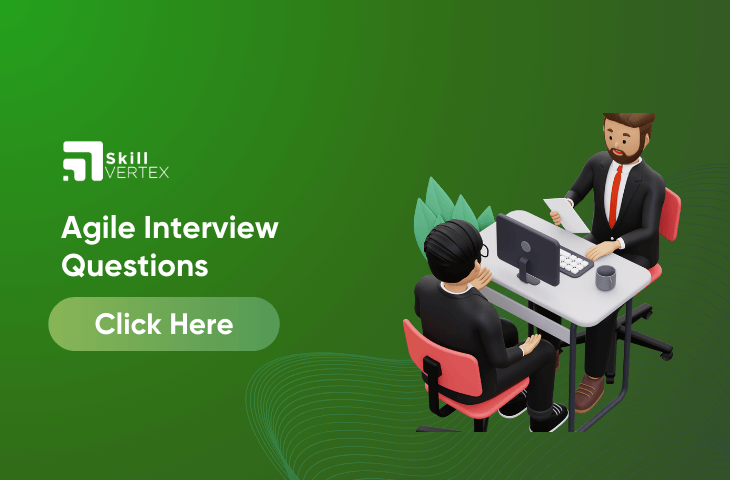1. Explain Agile Testing?
2. Name the most important components of agile?
3. What is the difference between agile and traditional project development?
4. Do you have a certification in Agile Testing?
5. What are the advantages of an agile model?
6. What are the roles in agile?
7. What is velocity?
8. Do you know some agile frameworks?
9. What is an ideal sprint length?
10. What is burn-down chart?
11. What qualities should an agile tester have?
12. Explain agile manifesto?
13. Which testing is done during agile?
14. What are the main agile quality strategies?
15. State the difference between Agile and Scrum.
16. How long the Scrum cycle last?
17. What is Scrumban?
18. What is the role of Sashimi in Scrum?
19. What is Product Backlog & Sprint Backlog?
20. Explain a test stub.
21. What is Test Driven Development (TDD)?
22. What is Sprint Zero?
23. What is Spike?
24. How will you define storyboard in Agile?
25. What are Epic, User Stories, and Tasks?
26. What is “Build Breaker”?
27. What are Prototypes and Wireframes used for?
28. What is API?
29. Are you aware of any drawbacks of the Agile model?
30. What is RC?
31. What is a product roadmap?
31. What is a product roadmap?
32. Name some Agile project management tools.
33. What are the popular Agile Scrum certifications one can take?
34. Name different types of impediment?
35. Mention some of the advantages of pair programming?
36. Name the components in the user story?
37. Name the various estimation methods in agile?
38. What is the main objective of the Sprint Burndown chart?
39. Who can re-prioritize the timeboxed plan if it is required?
40. What X and Y-axis describe in the burndown chart?
41. Describe refactoring in Agile?
42. What is a tracer bullet in Agile?
43. Explain Kanban in Agile?
44. What is the difference between Incremental and iterative development?
45. Explain what is Zero sprint in Agile?
46. Mention the most critical agile Matrices?
47. What are the conditions where we don’t have to use Agile?
48. How does QA provide benefits to an agile team?
49. What is the main difference between Agile and Waterfall?
50. Name the 12 Agile principles.
51. Name the three different roles in Scrum.
Agile Interview Questions And Answers
- Explain Agile Testing:
Ans.Agile Testing is a testing approach that aligns with the principles of Agile software development. It emphasizes collaboration, adaptability, and responsiveness to change. Testing occurs concurrently with development in short cycles, allowing for quick feedback and continuous improvement.
2.Most Important Components of Agile:
Ans.
- User Stories: Short, client-focused descriptions of functionality.
- Sprints: Time-boxed development cycles.
- Backlog: Prioritized list of features or tasks.
- Daily Stand-ups: Brief team meetings for updates.
- Incremental Delivery: Regular, small releases of working software.
3.Difference Between Agile and Traditional Project Development:
Ans.
- Agile: Iterative and incremental, adaptive to changes, client involvement throughout.
- Traditional: Linear and sequential, resistant to changes, client involvement mainly at the beginning and end.
4.Certification in Agile Testing:
Ans. Mention relevant certifications if applicable, such as ISTQB Agile Tester or Certified ScrumMaster.
5. Advantages of Agile Model:
Ans.
- Faster time-to-market.
- Improved flexibility and adaptability.
- Continuous client feedback.
- Enhanced collaboration and communication.
- Early and frequent delivery of valuable features.
6.Roles in Agile:
Ans.
- Product Owner: Represents client interests.
- Scrum Master: Facilitates the team and removes obstacles.
- Development Team: Cross-functional members responsible for delivering the product.
- Stakeholders: Individuals or groups with an interest in the project.
7.Velocity:
Ans.Velocity is a metric in Agile representing the amount of work a team can complete in a sprint. It helps in planning and forecasting future sprints.
8.Agile Frameworks:
Ans.
- Scrum: Iterative and incremental, with roles like Scrum Master and Product Owner.
- Kanban: Continuous delivery, visualizing work on a board.
- Extreme Programming (XP): Emphasizes coding and testing practices.
- Lean: Focuses on minimizing waste and maximizing value.
9.Ideal Sprint Length:
Ans.Sprint length varies but commonly ranges from 1 to 4 weeks. The ideal length depends on the team’s capacity and the nature of the project.
10.Burn-down Chart:
Ans.A burn-down chart visually represents completed work versus remaining work over time in a sprint. It helps teams track progress and predict if work will be completed on time.
11.Qualities of an Agile Tester:
Ans.
- Collaboration and communication skills.
- Adaptability to change.
- Focus on delivering value to the customer.
- Continuous learning and improvement mindset.
- Ability to work in a cross-functional team.
12.Agile Manifesto:
Ans.
- A set of guiding values and principles for Agile development, emphasizing individuals and interactions, working software, customer collaboration, and responding to change over processes and tools.
13.Testing During Agile:
Ans.
- Unit Testing: Developers test individual components.
- Acceptance Testing: Ensures delivered features meet client expectations.
- Continuous Integration Testing: Automated tests integrated with code changes.
- Exploratory Testing: Ad-hoc testing to discover defects.
- Regression Testing: Ensures new changes don’t break existing functionality.
Hello, I’m Hridhya Manoj. I’m passionate about technology and its ever-evolving landscape. With a deep love for writing and a curious mind, I enjoy translating complex concepts into understandable, engaging content. Let’s explore the world of tech together

